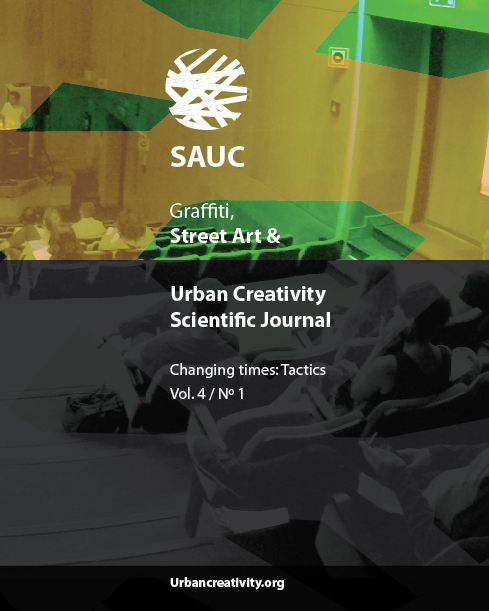Documenting graffiti culture:
an evolution of content
DOI:
https://doi.org/10.25765/sauc.v4i1.132Abstract
Since its early years, graffiti has been documented with photographs and videos, showing legal and illegal activities in the streets. The most famous photographer of this time will always remain Martha Cooper, who still runs her photographer activities and is invited to the most important events of the graffiti culture in the world. In the mid-seventies, the first digital camera was coming out leading towards a real revolution in filming and photography. Technology has then developed extensively and cameras with higher resolution allowed graffiti writers and audio-visual artists to produce work of higher quality and with new visual perspectives. This progression in time has changed the way of documenting graffiti culture and has expanded its possibilities in terms of visual content, thanks to the democratization of technologies and its improvements. I have photographed and filmed a few groups of graffiti writers, which gave me insight into this culture. This essay wishes to introduce some thoughts on this subject and open a longer discussion concerning the importance of audio-visual material for graffiti as an ephemeral art form.
Downloads
Global Statistics ℹ️
|
248
Views
|
0
Downloads
|
|
248
Total
|
|
Downloads
Published
How to Cite
Issue
Section
License
Those authors who publish in this journal accept the following terms:
-
Authors retain copyright.
-
Authors transfer to the journal the right of first publication. The journal also owns the publishing rights.
-
All published contents are governed by an Attribution-NoDerivatives 4.0 International License.
Access the informative version and legal text of the license. By virtue of this, third parties are allowed to use what is published as long as they mention the authorship of the work and the first publication in this journal. If you transform the material, you may not distribute the modified work. -
Authors may make other independent and additional contractual arrangements for non-exclusive distribution of the version of the article published in this journal (e.g., inclusion in an institutional repository or publication in a book) as long as they clearly indicate that the work was first published in this journal.
- Authors are allowed and recommended to publish their work on the Internet (for example on institutional and personal websites), following the publication of, and referencing the journal, as this could lead to constructive exchanges and a more extensive and quick circulation of published works (see The Effect of Open Access).













